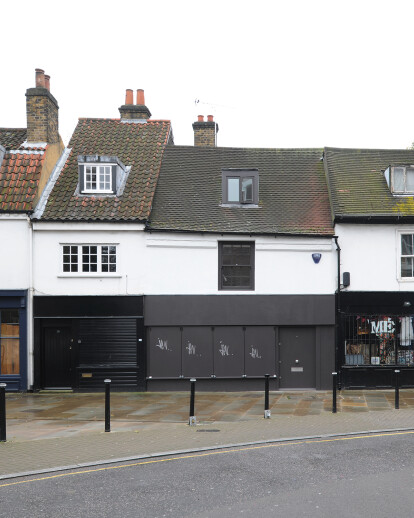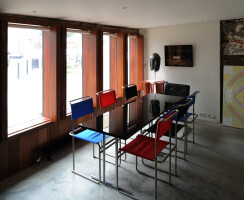Dow Jones Architects have completed a restoration of a Grade II listed late 17th Century timber framed house in Deptford, South East London. The premises was the home of Whitcomb Cycles, founded in 1949, one of the last handmade steel bicycle frame builders in the UK until its closure in 2009. The project transforms this workshop into a home and private gallery.
The plan in the existing house is organized around a new double winder timber staircase and a large sculptural 300-year-old brick chimney. These two components are not only practical elements of building, but divide the plan spatially into a series of interconnected spaces of varying form and character on the ground, first and second floor. The usefulness of these components and the beauty of the spaces they affect as a consequence create the architecture of this place.
A tall single storey extension is made to the rear of the house. A timber framed glazed courtyard punctures the middle of the reordered ground floor plan. This not only allows fresh air and light into the space but also resolves the complex geometry of the site boundary. Sapele hardwood doors hang on sliding door gear or parliament hinges allowing this little piazza to become part of the differing areas of the ground at different times of the day. Black granite uncut sets form the ground of the courtyard, their orientation emphasizing the geometry of what is new and what is old. The southern end of the plot increases in height again where a full width openable roof light allows sun and daylight down over the glazed tiled walls above the concrete kitchen worktop.
A Sapele hardwood shop front alters the Tanners Hill facing elevation. A 1m wide front door enables large works of art to be brought into the ground floor gallery space. The shop front stall riser is then divided into four glazed bays that each have internal and external shutters allowing flexibility of the shopfront’s use and display.
A poured polished concrete floor unifies the internal ground floor.
A 100mm deep timber studwork frame is made inside the original lath and plaster walls of the existing house. This allows the preservation of the listed building fabric behind the stud and also the ability to highly insulate between the stud frame. Rockwool was used in the party walls and Celotex in the exterior walls. This inner frame is then plasterboarded and forms the walls of the rooms. The strange thickness (450mm) of these insulted walls is made known at the window reveals. Existing beams and joists are strengthened by doubling up with new timbers where necessary and 18mm plywood sheeting fixed across the second floor joists acts as a structural diaphragm adding further strength. Elements of the original building fabric are revealed at selected moments. The axis mundi of the brick chimney is left exposed almost in its entirety with openings reinstated on all three floors. The long ground floor lath and plaster wall is left exposed in order that the ground floor area remains as large as possible and the cranked southern boundary brick wall is also left visible. As many of the original timber floor boards were salvaged as possible. The widest (250mm) being placed on the second floor master bedroom and en suite. These were complemented with new additional 120mm boards in the first floor studios. The new boards and the staircase then had a dark brown floor stain applied to match the original boards as closely as possible. All timbers where then unified and protected with Osmo Polyx oil. One can differentiate between the age of boards then not by colour but by the width of board and the subtle textural differences.
The first and second level floors remain un-horizontal as found, each gradually falling away from the four main beams in the middle of the plan towards the exterior walls. All sockets and switches are then placed locally in each room across a datum horizon. This horizon is set from the highest floor position within each room, sockets at 450mm and switches at 1100mm. The horizon of sockets and switches then reveal to our eye that the timber floors are not horizontal and elevates the ordinary placement of these building elements into a physical architectural idea. The placement of radiators within these four rooms is dealt with in the same way.
Timber casement and sash windows are remade to match the existing designs on the first and second floor but now including double glazed units with energy efficient Pilkington K glass used on the inner leaf.
The project is enhanced by the fantastic working relationship during the 23 week build with the main contractor; Fullers Builders, who specialize in the conservation and restoration of buildings of historic importance. Their expertise in solving problems that emerge when working with an existing building has lifted the project enormously.
This project involves the excavation of a series of interconnected spaces of varying character from an under-maintained and neglected building of historical importance. A strong structural and environmental strategy enhances architectural ideas about material and light and creates a project that is rooted deeply to the history of the building and its site.

































